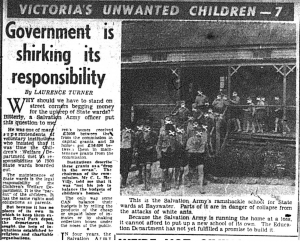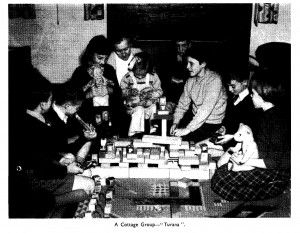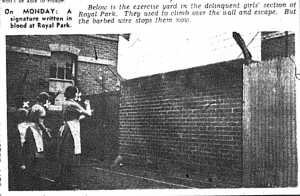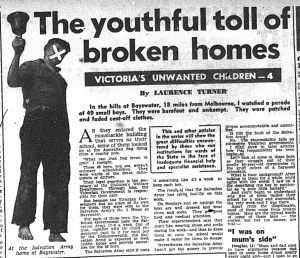Recently I’ve been working on an article about children’s institutions in Victoria in the early 1950s. This work saw me actually get up from my desk and leave the office to do some research – at Public Record Office Victoria, the State Library of Victoria , the University of Melbourne Archives and at the National Library of Australia in Canberra. These days, there is so much digitised historical material to access via desk-based research that a historian can get lazy …
Trove has transformed the way we research Australian history, but I’m glad that it didn’t exist when I did my history degree. Otherwise, I would never have known the satisfaction of finding an article in a nineteenth century local newspaper after hours of work in some library basement. (Although I don’t miss the seasickness that often came from too much time poring over the microfilm reader.)
My research for this article was made so much easier by being able to hop onto Trove and search the digitised copies of The Argus and the Truth on Trove. I also made good use of The Age on the Google News Archive, even though this resource is much less user-friendly. Sitting here at the desk, I was able to read copies of annual reports of the Child Welfare Department and the Mental Hygiene Authority from the 1950s, via the Victorian Parliamentary Papers Database.
From the mid 1950s, the Child Welfare annual reports featured photographs of buildings and sometimes of children and staff (unfortunately the web versions aren’t great quality, and of course, the photographs are very obviously posed – like this one from Turana on p.9 of the Report for 1956).
But it’s good to be reminded sometimes that not everything is on the web, not yet anyway. In the Newspapers room at the State Library of Victoria, there are subject indexes to the Sun (January 1929 to November 1970) and the Herald (January 1926 to Noember 1970). These handwritten index cards were most likely created by employees at the Herald and Weekly Times and somehow found their way to SLV. These newspapers often published articles about children’s homes in Victoria, and the children who lived in them. Over the years, I have used these index cards to make lists of articles that I want to chase up and possibly make copies of.
In March this year, I travelled to Canberra for an event at the National Archives of Australia, and managed to squeeze in a couple of hours looking at 1950s newspapers in the National Library of Australia. I was pleasantly surprised at the technological developments that have occurred since I last went near a microfilm reader (although I still felt a bit woozy). In the short time available, I chased up a series of articles published in the Herald in late 1952. From 25 October 1952, the Herald featured daily articles by Laurence Turner, under the heading ‘Victoria’s Unwanted Children’.
There were 8 of these articles in total, and they generated more discussion in the newspapers, with letters from readers, editorials and commentary from the Victorian government, care providers and various experts. This series was published in the months leading up to the election that saw the Cain Labor government come to power in December 1952.
The first article in the series, ‘Black eyes at Royal Park’ (The Herald, 25 October 1952, p.13) began:
Today, of about 3100 children committed to the care of the State of Victoria, about 1100 are with foster-parents or relatives.
Seventeen hundred others – delinquents, subnormals, drifters, and other products of broken or unlucky homes – live in institutions. Three hundred live out at places where they work.
What is the State doing for them? How are they being treated? What does the future hold for them?
In search of the answers, a Herald staff reporter inquired into the operations of the Children’s Welfare Department, visited many institutions, and talked with scores of people trying to do their best with the young flotsam and jetsam of the community. This is the first of his series of factual reports.
In ‘Victoria’s Unwanted Children’, Turner argued that Victoria was ‘shirking its responsibility’ to its vulnerable children, ‘farming out’ its State wards to institutions run by charitable and religious organisations. At that time, the only institution run by the Victorian government was the Royal Park Depot. The photos illustrating these articles provide rare glimpses of Victoria’s institutions and their residents.
The photos are all marred by the newspaper’s clumsy attempt to presumably protect their privacy, by placing crude crosses over their faces.
The obscured faces of these children and young people in these Herald photos unwittingly reinforce the point that has been made by so many people who went through the child welfare system, that life in a children’s Home robbed you of your identity.

‘… the Salvation Army’s ramshackle school
for State wards at Bayswater’
(The Herald, 1 November 1952, p.7)
I still have a long list of articles to chase up, from publications that aren’t part of Trove’s digitised newspapers. (For example, The Sun also ran a series about how Victoria was ‘Cheating Children’ in September 1953.) Another motivation for me to get away from the desk …




June 25, 2015 at 2:21 pm
Wondering whether there is an app to be built on the Trove API that allowed for browsing through newspaper articles of relevance? But then also to be able to interactively interconnect with other records and sources.
June 9, 2015 at 6:56 pm
Most interesting! It sent me scurrying after articles in The Age that I wanted to catch up with. I agree that an historian can get lazy with so much now online. But I was recently reminded that there is also a terrific resource that historians sometimes overlook – and that’s the personal accounts of older Care Leavers. I accompanied a frail old man to an interview with a legal entity (I can’t reveal the context) where he told his story about life in two institutions. I was gobsmacked at how well he reconstructed his childhood – and although he got a few dates wrong, he was crystal clear about the significant events that shaped his life from a childhood that was appalling. History is not not fashioned only from written documents: some people are the virtual documents of history. And we must listen carefully to what they can tell us. I could hardly wait to get home to make detailed notes (with his permission). A priceless couple of hours.
June 10, 2015 at 8:07 am
A very interesting post Cate! I was asked to review an article for publication recently which relied totally on references sought through Trove. Unfortunately, this meant that the author had a) not read my own article on the topic and therefore b) had not referred to a very important archive that is housed in an accessible local history collection. It weakened the argument. Not catastrophically, but enough to suggest that the article shouldn’t be published without review. I stress, that this was not an attempt by me to act as gatekeeper. I think history is a process of research, writing, publication, debate, revision…But to rely totally on Trove in this case was a bit like phoning the story in without actually speaking to anyone who was there.
And I totally agree with Frank about the importance of oral testimony. Where archival collections exist, their relevance as evidence can only be improved (or disproved!) by the inclusion of personal narrative if it can be obtained. It’s bizarre that there is still a resistance to the evidence of memory in some quarters, due to its ‘constructedness’. As if the average newspaper article isn’t constructed!
So – Trove is great – but it can be as unreliable witness as the June 10 2015 issue of the Herald Sun. As always – multiple sources in a variety of genre make for better history!